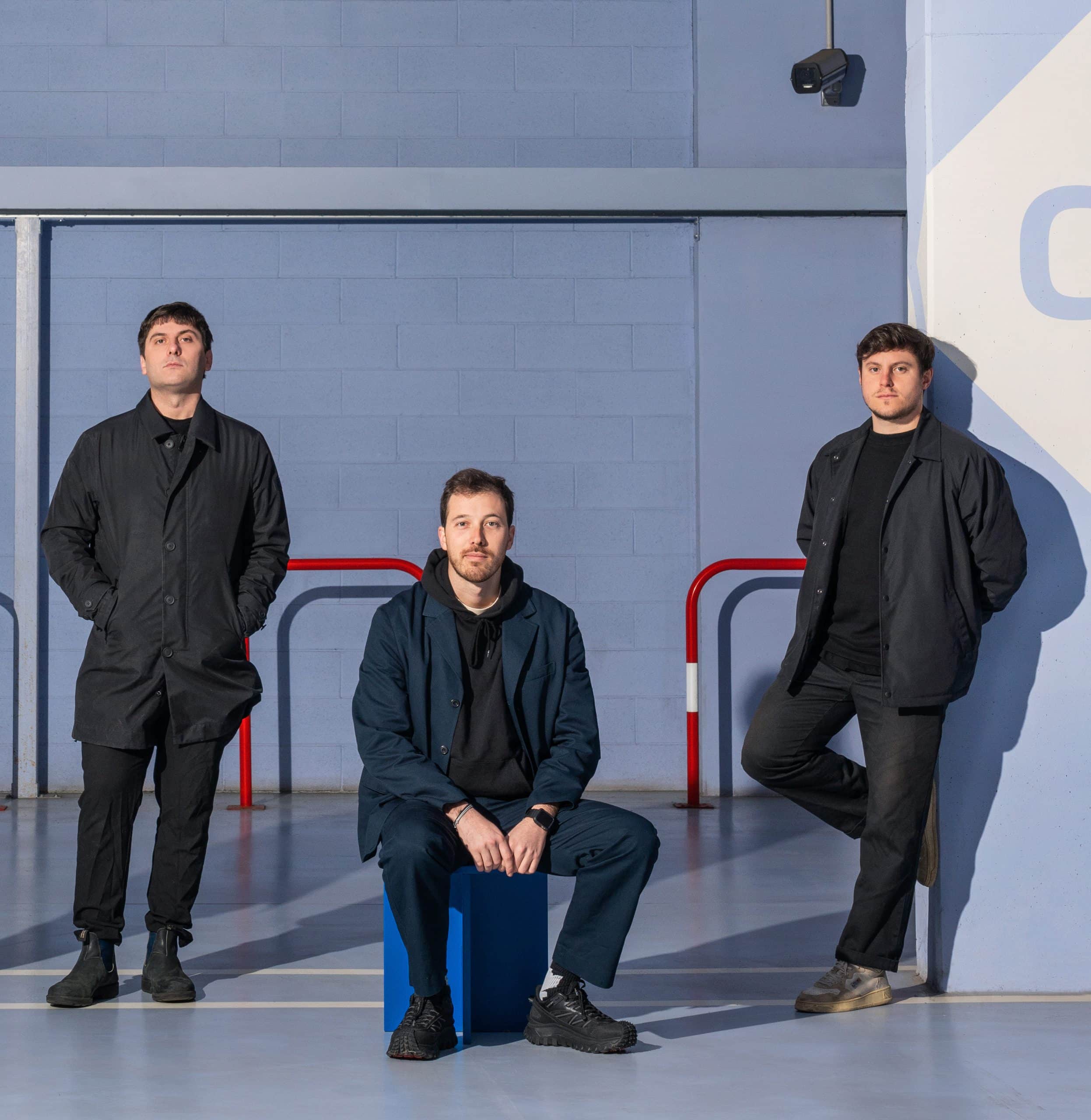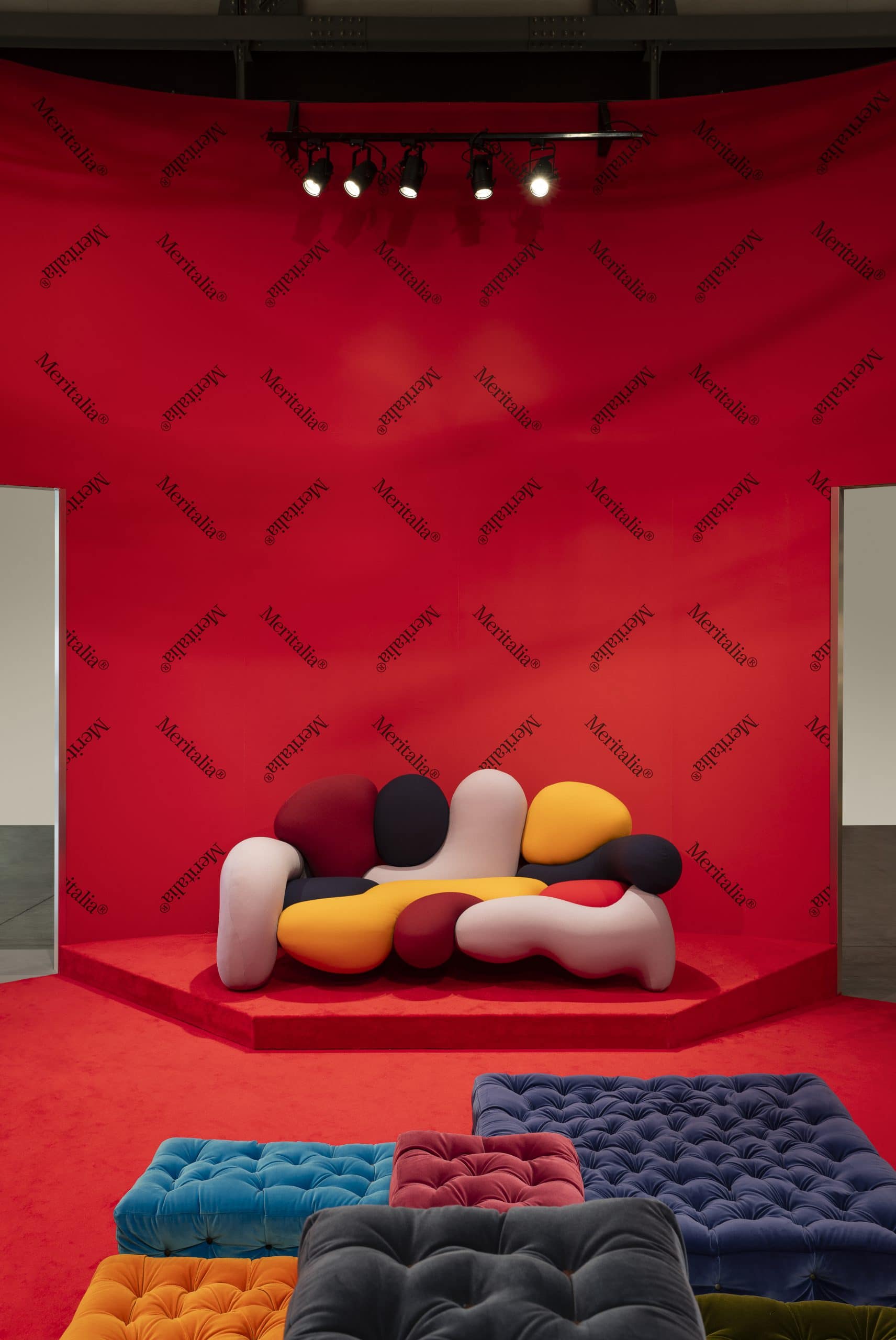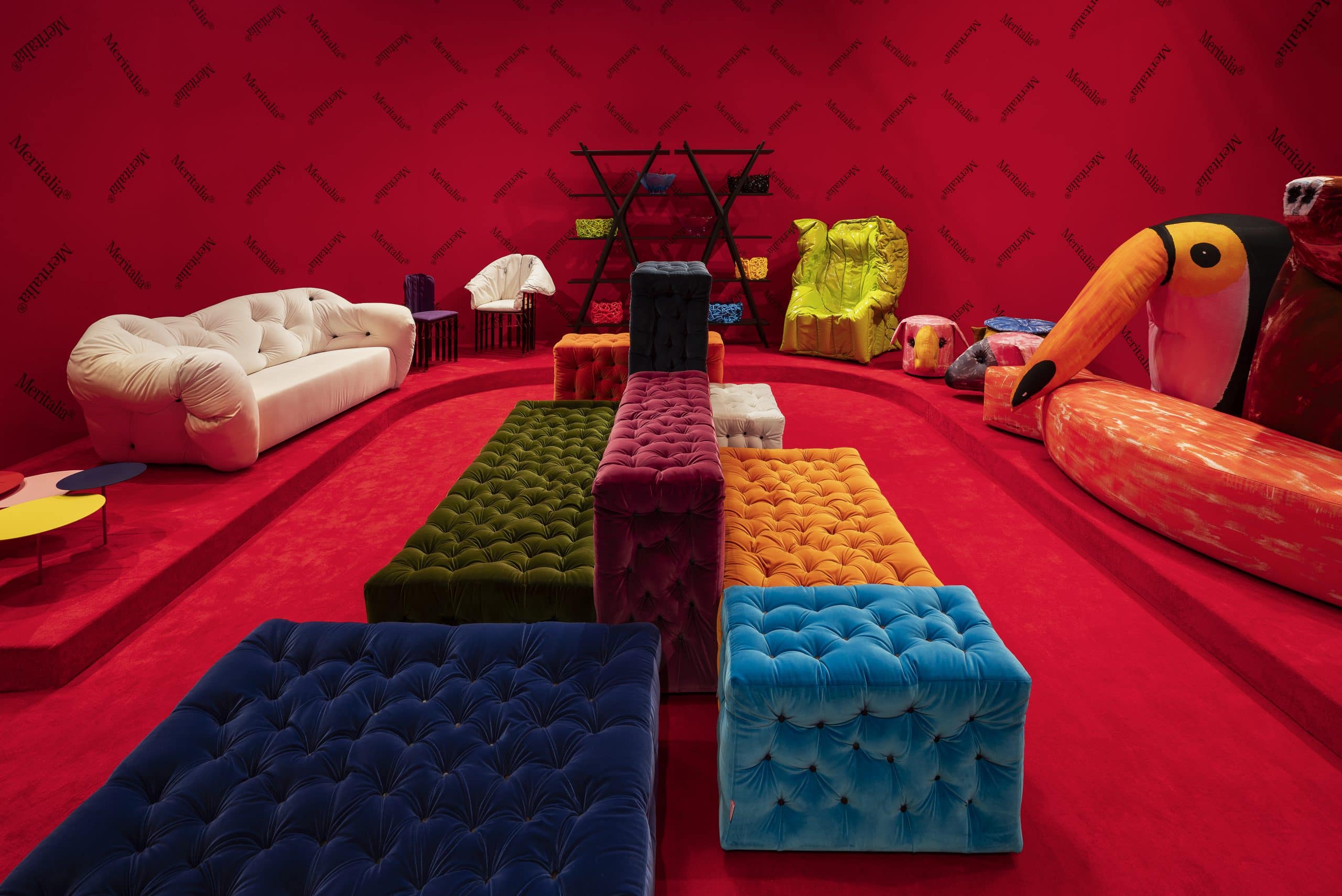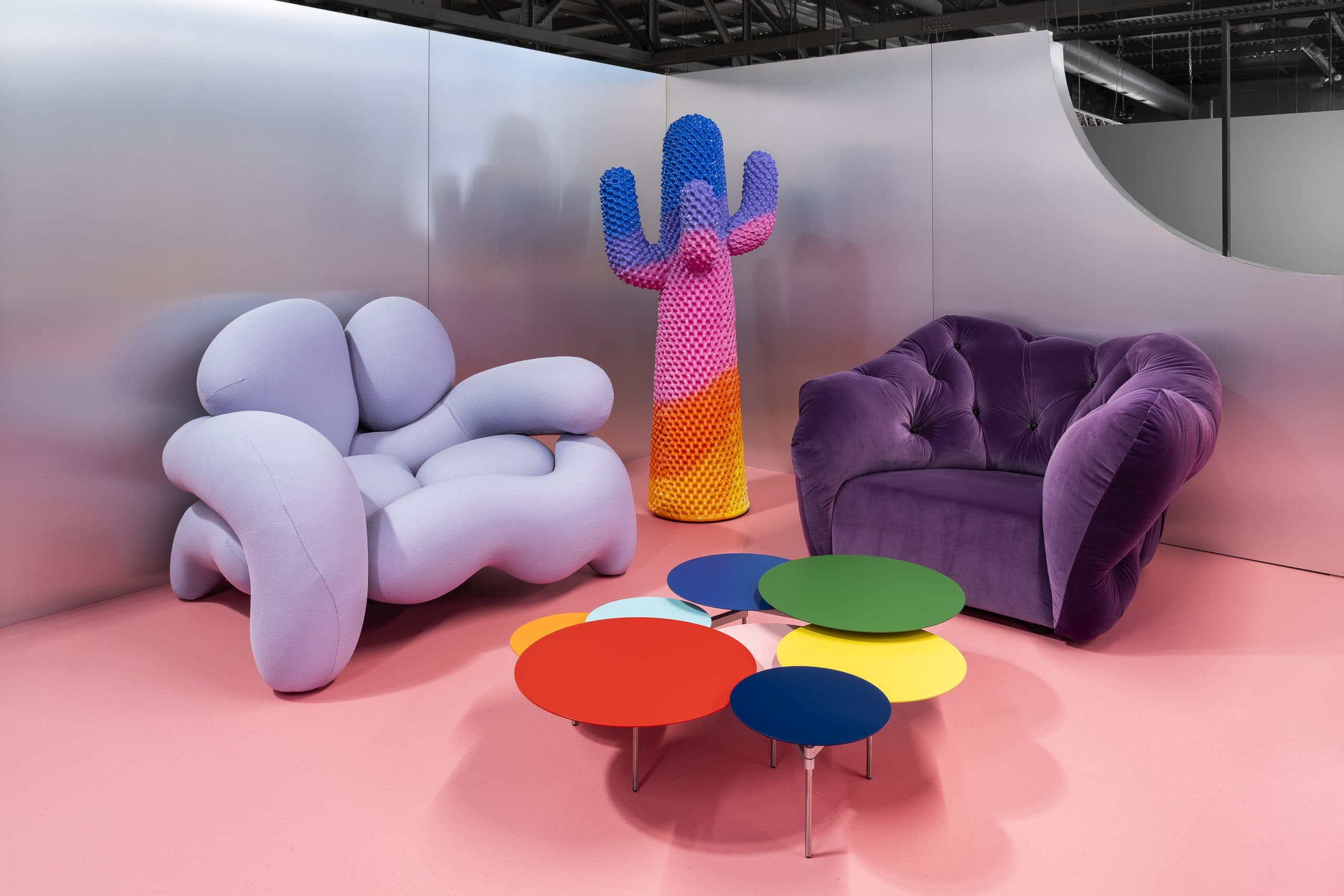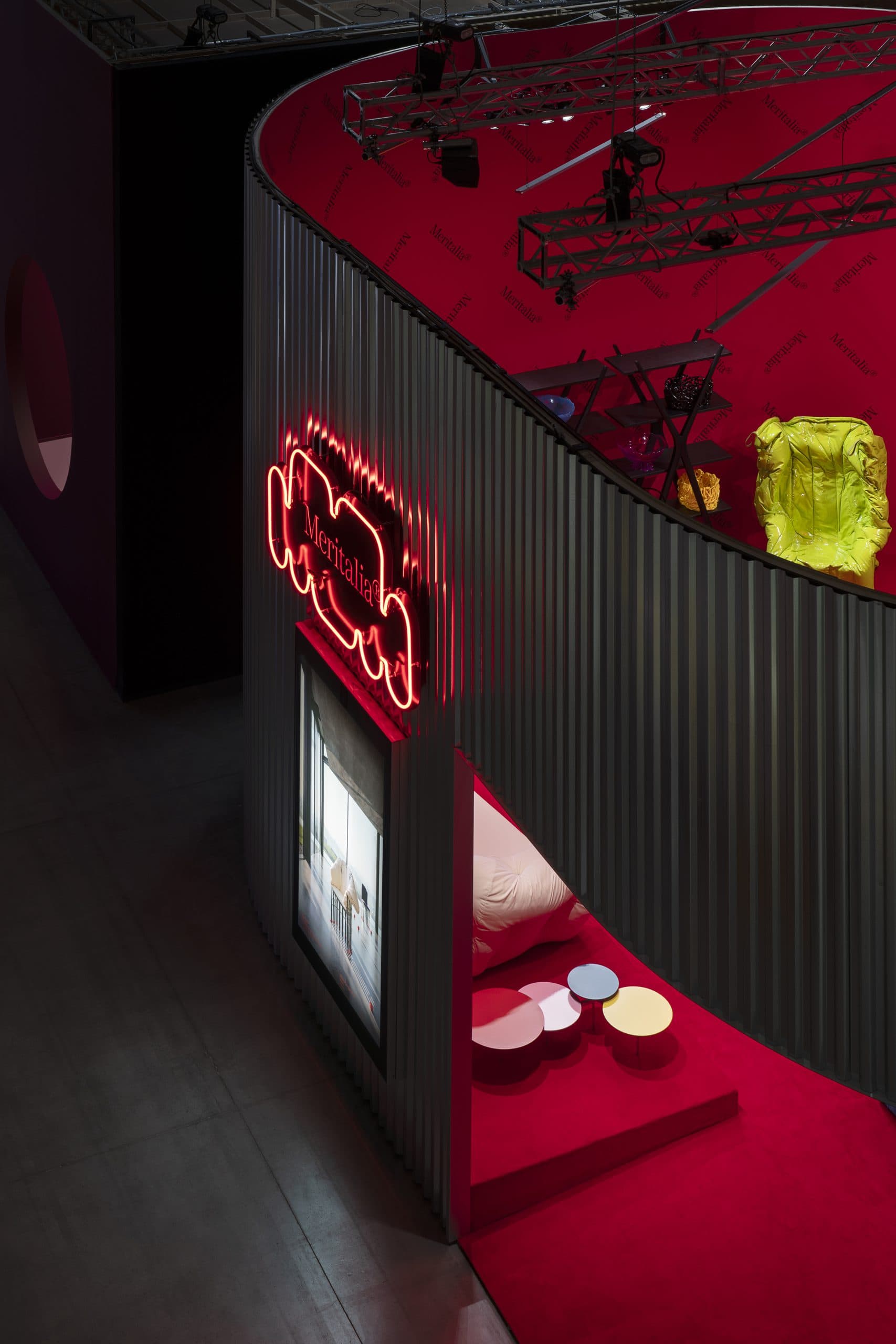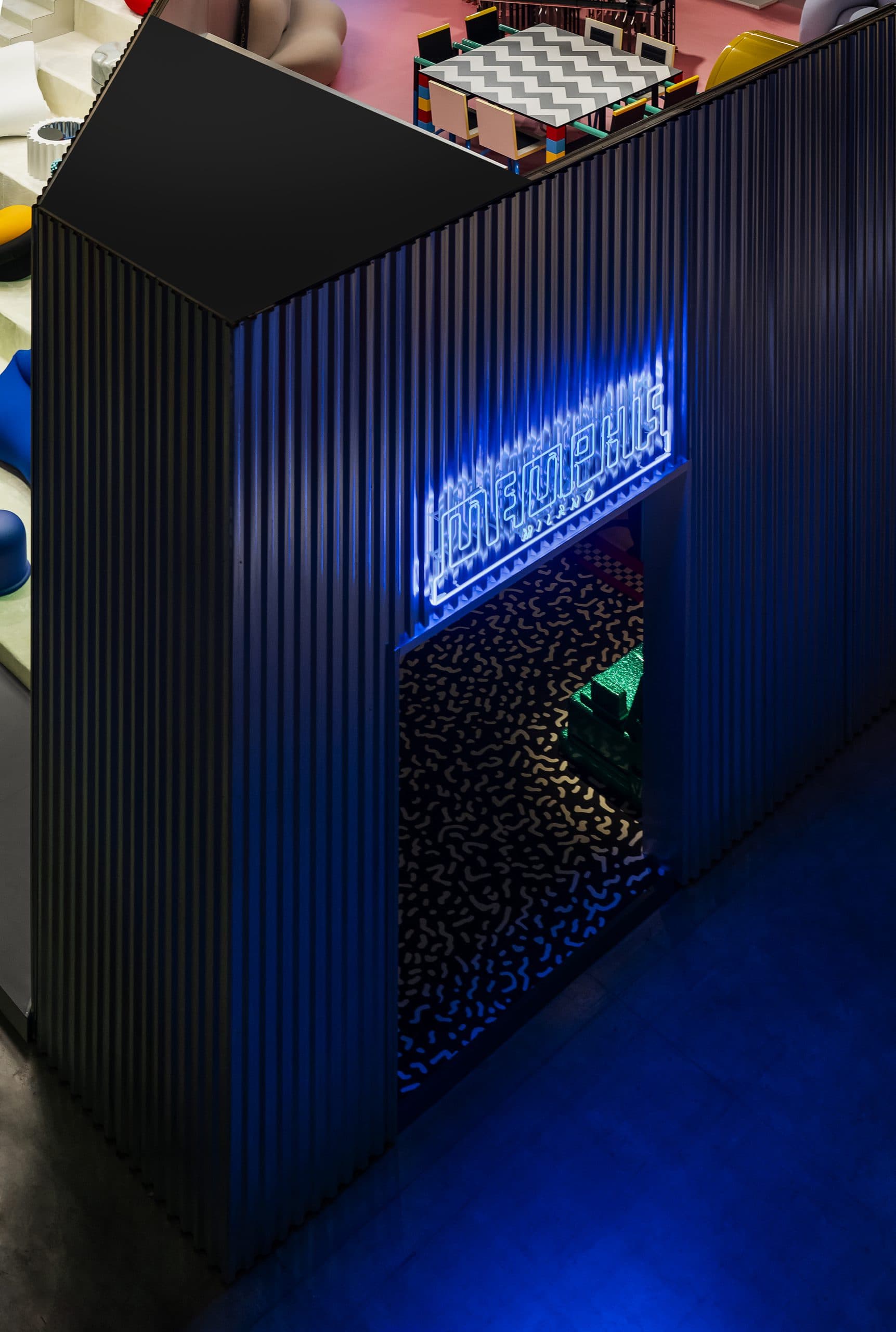The architecture studio (AB)NORMAL has designed the Italian Radical Design pavilion, hosting the group’s brands Gufram, Memphis Milano, and Meritalia. “Designing the space for Italian Radical Design has been a stimulating challenge, requiring both analytical and creative approaches. The main objective was to highlight the distinctive identities and the unique avant-garde of the three brands, in a single cohesive spatial expression. We explored a wide range of visual and cultural inspirations, ranging from influences of the ’80s to the present day. Collaborating with Italian Radical Design granted us the opportunity to immerse ourselves in the artistic expressions that have shaped the history of design” declare the co-founders of (AB)NORMAL, Mattia Inselvini, Davide Masserini, and Luigi Savio. For both Italian Radical Design and (AB)NORMAL, research is the core of their respective practices. Charley Vezza, CEO of Italian Radical Design, is dedicated to discovering new talents and expressions that deviate from the conventional; (AB)NORMAL, by definition, prefers the quest for the contemporary and the alternative. Entrusting the design for the pavilion to a studio with such characteristics highlights the innovative vision of Italian Radical Design, in the desire to reflect the original nature of each of its brands.
(AB)NORMAL is an interdisciplinary architecture studio based in Milan. Run by architects Mattia Inselvini, Davide Masserini and Luigi Savio, the studio’s work spans architecture, product design, and creative direction, across a wide array of domains including art, culture, design, interiors, and fashion. The creative process of (AB)NORMAL integrates iconic elements with nods to popular culture, with a particular focus on multidisciplinarity and the implications of technological progress. The result is a profound and widely understandable mosaic, architecturally grounded in the present yet conceptually responsive to change.
Ilaria Sponda: The Italian Radical Design’s space. What is radical to you in the approach you took to design the space?
(AB)NORMAL: We didn’t deliberately pursue a radical approach, nor we consciously seek an aesthetic that would subtly diverge from the typical salon setting. The scenography we crafted was meant to echo the narratives of the three brands, enriching their stories with a backdrop that fluidly adapted to emphasise the tactile qualities of the displayed products. These objects themselves are radical, firmly rooted in design history yet boldly defying convention. Perhaps, in today’s context, the truly groundbreaking decision is to participate in the Salone del Mobile with fresh ideas, challenging the established norms of the exhibition. These fairs are like temporary cities, emerging and vanishing within weeks, demanding architectural thinking while offering rich inputs for creative exploration.
IS: How have you interpreted the three brands in the pavilion, and why? What is unique to you about them?
(AB)NORMAL: It wasn’t easy to display the wide range of products selected from the three catalogs. Gufram, Memphis Milano, and Meritalia each bring very different furnishing ideas to the table. Gufram’s products are bold statements that turn into domestic icons through scale manipulations and material simplifications. On the other hand, Memphis Milano offers a holistic domestic vision, wrapping the home space in vibrant patterns and colours. And then there’s Meritalia, with its incredible range of experimental forms exploring the production process. We decided to create three autonomous cells, each with its own internal finishes but brought together by the reflections of the metal shell.
IS: What can be saved from the 80s design? How is that still relevant in the now?
(AB)NORMAL: We don’t perceive the chronological sequence of design history as a dogma. The passage of time doesn’t always correspond to obsolescence for us. Historical epochs coexist, overlapping in a layering of styles, typologies, and production processes. We don’t consider the 80s obsolete; on the contrary, within the cultural postmodern context, the timeline isn’t linear or predictable. The 80s, like the 90s or the early 2000s, are destined to resurface in cycles that are difficult to foresee. This lack of control allows for creativity, which in the realm of design, as well as fashion, is always seeking aesthetic reboots.
IS: And what does it mean to be an architect today? What are the challenges of being a studio of three different minds?
(AB)NORMAL: The traditional role of the architect is somewhat diluted nowadays, which is not news. The failure of political ideologies has greatly weakened the value of urban planning. We stopped designing cities when the neoliberal market replaced the structure of the public sector. Construction increasingly prioritises profit over creating quality spaces. However, this doesn’t necessarily mean the disappearance of the architect’s role. Instead, today’s times demand mental freshness and great adaptability. (AB)NORMAL was conceived as an interdisciplinary studio from the outset, as an experiment that merges many disciplines and diverse artistic expressions into architectural practice. It is precisely this aspect of our studio that creates a common ground, allowing three very different personalities to express themselves freely while maintaining a certain design coherence. Ultimately, we influence each other, often becoming our own reference points. This is how the design identity of (AB)NORMAL is built.
IS: What’s your favorite object from the installation at the pavilion?
(AB)NORMAL: All these products are truly remarkable, but among them, the Shadow, designed by the late Gaetano Pesce, is a masterpiece. The thermoforming process of the polyurethane core astounded us. It’s a simple yet ingenious concept that translates into a timeless object. Due to its finishes and production process, the Shadow remains exceptionally contemporary.
IS: I’d like to discuss friction and its link with aesthetics in contemporaneity. What’s your take on that?
(AB)NORMAL: It’s quite a complex question to tackle. It would require the pages of a book, and there are probably authors far more knowledgeable than us on the topic. Nonetheless, we’ll try to offer a personal take on why today, conflict, and friction serve as tools for narrative construction and artistic creation. We’re living in incredibly fascinating yet tumultuous times. It wouldn’t be accurate to describe our era as one marked by peace and harmony. Recent geopolitical upheavals, for instance, are indicative of the erosion of the status quo we’ve known for the past 80 years of global history. These moments of turmoil have recurred throughout history, characterised by an aesthetic of contrasts, ruptures, and stylistic incongruities. Consider the expressive freedom and formal divergence of works from the Hellenistic era or the lavish opulence of the Baroque period, the bold engineering of Russian Constructivism, or the exaggerated irony of Balenciaga. It’s evident that working with friction, contrast, or, more precisely, aesthetic incongruity, has long served as an expressive tool to navigate troubled times like ours.
IS: How do you transform fiction into practice?
(AB)NORMAL: It comes naturally to us because we’re products of these times. After all, we wouldn’t call ourselves (AB)NORMAL otherwise.
IS: How is your creative journey when designing a space? And what’s the challenge of curating a space in a fair?
(AB)NORMAL: Our work doesn’t follow a set recipe, but there are certain recurring methods we employ. We’re not shy about admitting that we’ve learned a great deal from observing Gufram’s creations and drawing inspiration from Meritalia’s adventurous material and formal explorations. References to these two entities have been evident since the inception of our journey. Our creative process often begins with a meticulous collection of cinematic, visual, and musical references. From there, we aim to distill an atmosphere, or as the Germans aptly put it, a Stimmung. It’s a creative journey that we often find mirrored in the works of the individuals and groups we collaborate with. The concept of “mood” is wonderfully vague and open to interpretation, allowing us to explore various directions. Speaking about Salone, as we’ve mentioned before, the commercial context doesn’t daunt us. Indeed, we see it as an opportunity to create something unexpected against a backdrop of conventionality. This environment provides us with a fertile ground to play with contrasts and surprise.
